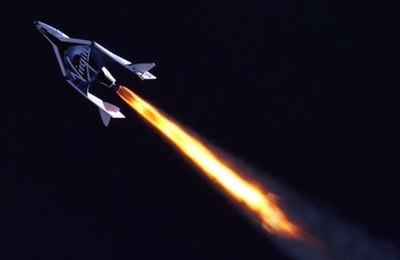 First radar images of
asteroid 1998 QE2 were obtained when the asteroid was about 3.75 million
miles (6 million kilometers) from Earth. The small white dot at lower
right is the moon, or satellite, orbiting asteroid 1998 QE2.
Image credit: NASA/JPL-Caltech/GSSR
First radar images of
asteroid 1998 QE2 were obtained when the asteroid was about 3.75 million
miles (6 million kilometers) from Earth. The small white dot at lower
right is the moon, or satellite, orbiting asteroid 1998 QE2.
Image credit: NASA/JPL-Caltech/GSSR
› Larger image
May 30, 2013
The radar imagery revealed that 1998 QE2 is a binary asteroid. In the near-Earth population, about 16 percent of asteroids that are about 655 feet (200 meters) or larger are binary or triple systems. Radar images suggest that the main body, or primary, is approximately 1.7 miles (2.7 kilometers) in diameter and has a rotation period of less than four hours. Also revealed in the radar imagery of 1998 QE2 are several dark surface features that suggest large concavities. The preliminary estimate for the size of the asteroid's satellite, or moon, is approximately 2,000 feet (600 meters) wide. The radar collage covers a little bit more than two hours.
The radar observations were led by scientist Marina Brozovic of NASA's Jet Propulsion Laboratory, Pasadena, Calif.
The closest approach of the asteroid occurs on May 31 at 1:59 p.m. Pacific (4:59 p.m. Eastern / 20:59 UTC), when the asteroid will get no closer than about 3.6 million miles (5.8 million kilometers), or about 15 times the distance between Earth and the moon. This is the closest approach the asteroid will make to Earth for at least the next two centuries. Asteroid 1998 QE2 was discovered on Aug. 19, 1998, by the Massachusetts Institute of Technology Lincoln Near Earth Asteroid Research (LINEAR) program near Socorro, N.M.
The resolution of these initial images of 1998 QE2 is approximately 250 feet (75 meters) per pixel. Resolution is expected to increase in the coming days as more data become available. Between May 30 and June 9, radar astronomers using NASA's 230-foot-wide (70 meter) Deep Space Network antenna at Goldstone, Calif., and the Arecibo Observatory in Puerto Rico, will perform an extensive campaign of observations on asteroid 1998 QE2. The two telescopes have complementary imaging capabilities that will enable astronomers to learn as much as possible about the asteroid during its brief visit near Earth.
Radar is a powerful technique for studying an asteroid's size, shape, rotation state, surface features and surface roughness, and for improving the calculation of asteroid orbits. Radar measurements of asteroid distances and velocities often enable computation of asteroid orbits much further into the future than if radar observations weren't available.
NASA places a high priority on tracking asteroids and protecting our home planet from them. In fact, the United States has the most robust and productive survey and detection program for discovering near-Earth objects. To date, U.S. assets have discovered more than 98 percent of the known Near-Earth Objects.
More - Link >>> http://www.jpl.nasa.gov/news/news.php?release=2013-182&cid=release_2013-182
NASA Science News: "Approaching Asteroid Has Its Own Moon" -
Link >>> http://science.nasa.gov/science-news/science-at-nasa/2013/30may_asteroidmoon/
NASA Science News: "Big Asteroid Flyby" -
Link >>> http://science.nasa.gov/science-news/science-at-nasa/2013/30may_asteroidflyby/
Source: NASA/Jet Propulsion Laboratory.
Related Blog Posts ---
NASA Coverage: 1998 QE2 Asteroid Passes Earth Friday (2013 May 30):
Link >>> http://spacewatchtower.blogspot.com/2013/05/nasa-coverage-1998-qe2-asteroid-passes.html
Congress Debates NASA Asteroid Mission--or Back to the Moon? (2013 May 23):
Link >>> http://spacewatchtower.blogspot.com/2013/05/congress-debates-nasa-asteroid-mission.html
NASA Wants $100 Million To Catch An Asteroid (2013 March 30):
Link >>> http://spacewatchtower.blogspot.com/2013/03/nasa-wants-100-million-to-catch-asteroid.html
Want to receive SpaceWatchtower blog posts daily in your inbox ?
Send request to < spacewatchtower@planetarium.cc >.
gaw
Glenn A. Walsh, Project Director,
Friends of the Zeiss < http://friendsofthezeiss.org >
Electronic Mail - < gawalsh@planetarium.cc >
About the Editor/Author: < http://buhlplanetarium.tripod.com/#GAW >
SPACE & SCIENCE NEWS, ASTRONOMICAL CALENDAR:
< http://buhlplanetarium.tripod.
Twitter: < https://twitter.com/spacewatchtower >
Facebook: < http://www.facebook.com/pages/
Blog: < http://spacewatchtower.
Author of History Web Sites on the Internet --
* Buhl Planetarium, Pittsburgh:
< http://www.planetarium.
* Adler Planetarium, Chicago:
< http://adlerplanetarium.
* Astronomer, Educator, Optician John A. Brashear:
< http://johnbrashear.tripod.com >
* Andrew Carnegie & Carnegie Libraries:
< http://www.andrewcarnegie.
* Civil War Museum of Andrew Carnegie Free Library:
< http://garespypost.tripod.com >
* Duquesne Incline cable-car railway, Pittsburgh:
< http://inclinedplane.tripod.
* Public Transit:
< http://andrewcarnegie2.tripod.











